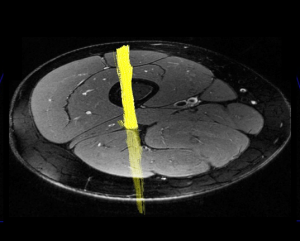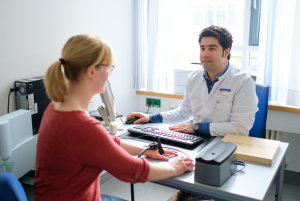Prof. Dr. Martin Bendszus
Department of Neuroradiology, Medical Faculty Heidelberg, Heidelberg University
PD Dr. Johann Jende
Department of Neuroradiology, Medical Faculty Heidelberg, Heidelberg University
Longitudinal analysis of structural and functional changes in peripheral circuits determining the clinical symptoms of painful diabetic neuropathy

Diabetic polyneuropathy comprises a wide spectrum of painful, but also non-painful symptoms related to structural and functional changes of neural circuits within the peripheral and central neuronal system. Therefore prospective in-patient studies will be performed to describe and understand subtypes of diabetic neuropathy, with the long term goal to pave the way for specific novel therapies. In combination of MRI neurography at 3T (Figure 1) and quantitative sensory testing (Figure 2) are performed to visualize structural changes of peripheral nerves in patients with diabetic neuropathy (DN) using anatomical sequences and to detect clinical relevant nerve fiber deficits.
The first results showed that the anatomical nerve lesions differ between patients with type 1 and type 2 diabetes. In addition, QST showed that already 75% of patients with prediabetes have the first neuropathic deficits associated with albuminuria. It has also been shown that diabetic neuropathy also affects the upper limb with comparable structural nerve lesions in MRI and severe limitations in daily life and quality of life. Moreover, the first data showed that patients with low cholesterol levels have more nerve lesions independent of statin therapy.
The next aims of the human studies are to investigate the natural course of diabetic neuropathy and the effect of high frequency muscle stimulation on symptoms, nerve fiber function and nerve structure integrity. Additionally, the influence of cholesterol lowering therapies would be observed in a intervention study. To further characterize the patients clinically, ultrasounds of carotid arteries and kidneys including perfusion, lung function testing, bioimpedance measurement, cardiac autonomous neuropathy testing as well as routine blood testing are performed.
natural course of diabetic neuropathy and the effect of high frequency muscle stimulation on symptoms, nerve fiber function and nerve structure integrity. Additionally, the influence of cholesterol lowering therapies would be observed in a intervention study. To further characterize the patients clinically, ultrasounds of carotid arteries and kidneys including perfusion, lung function testing, bioimpedance measurement, cardiac autonomous neuropathy testing as well as routine blood testing are performed.
Moreover, DNA-damage, senescence, advanced glycation endproduct and dicarbonyl measurements are performed in both peripheral blood, and skin biopsies. A additional intervention study will be performed to investigate the effects of a surgical nerve decompression on diabetic neuropathy in collaboration with the BG-Unfallklinik in Ludwigshafen.



















